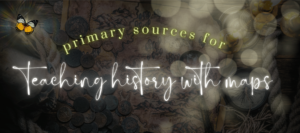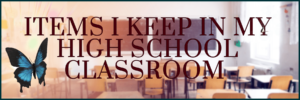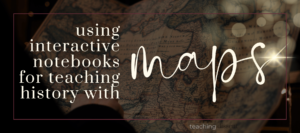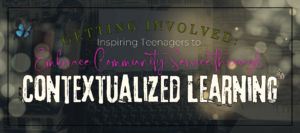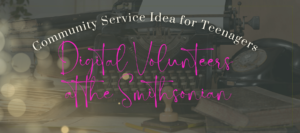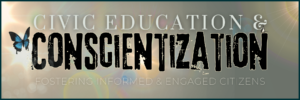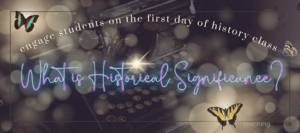For the first day of history class, I wanted to find an activity that engaged my high school students and resulted in, above all, a positive memory of their initial experience in my class. I wanted students to, when they were trying to recall the blur that was their first day of school, remember my class and my name with some kind of positive connotation. Some sort of warmth, and even, hopefully, even an inkling of curiosity.
On the first day of high school, kids have their days packed with back-to-back classes; their attention and behavior scrupulously monitored by some kind of bell system.
However it is dressed up, the truth underlying the public school experience is as follows. Our young people transition from the freedom of living (whatever reality has set for them) those summer months to the harsh, cold reality of a Thorndikean factory system in which we are training future workers. Bell rings: work starts. Bell rings again: work stops. Minutes are counted. Human bodily functions are regulated. Mobility is limited and surveilled. And we pretend it is normal. We pretend we agree. We pretend it is the natural order of things and that none of us has ever imagined another way.
Its brutal, really.
How to start the first day
For the first day of school, I have noticed that a lot of teachers will either dive directly into reviewing the syllabus for their class: they start by talking at kids and expecting kids to sit and listen and retain the information. Alternatively, many will attempt some kind of “name-game”, ice-breaker activity in an attempt to be “fun and relatable”… Kids see right through this, of course. Not only that, but I am pretty sure just stresses them out even more, because then they leave the class without any actual information about what will await them in the year ahead.
I’ve always felt so bad for kids on the first days of school…. Don’t get me wrong, I feel bad for me, too. Its hell! But mostly, I really feel bad for the kids: it must be mind-numbing, that constant performance. Waiting for the real class to start, wondering for the teacher to show who they really are.
The way I see it, kids absolutely need to know the following information about you and your class before they are going to care about anything else:
- How they can expect to be treated by you
- How they will be treated by other kids (who else is in there, what kind of behavior will be allowed, what all can people get away with, etc.)
- What is expected of them when they are in your room.
………..And then, some of them care how they will be graded. Although, most of them forget they care about that until the day before grades are due… but that is another story for another time.
Whether I am teaching middle schoolers who can barely remember where they put their pencil, or seniors so aloof and checked out they can’t be bothered with petty, childish tasks such as turning in assignments past winter break, my approach stems from the same fundamental belief:
the need to respect and honor children’s humanity and autonomy.
Something easily and often lost in our current system.

Dive into content as a way to establish norms
I mean simply that I want to respect the time, needs, and wishes of students as humans. And I don’t want to waste time talking about it, I would rather just do it. That’s the thing about kids. They see right through everything. It doesn’t matter what you say. It only matters what you do.
And we start the first day of school.
I begin the first day of history class with an activity that is content-related, interactive, requires participation, but above all… is perplexing.
The key to capturing their interest is to connect historical concepts to their lives in a meaningful and relatable way. Which is tricky when you are dealing with a generation who normalizes spying on the invented stories of each other’s lives and expect all information to arrive in small, quick, entertaining, easily digestible snippets or their attention spans shut off….. my god I am turning into an old grouch.
POINT: I wanted to showcase how history wasn’t just a collection of facts and dates, but a dynamic and evolving narrative that we all play a part in shaping.
To start with a question that I don’t have the answer for.
And that there really isn’t an answer for. Not only because I personally find those the most interesting questions, but because it emphasizes that the process is more important than the answer. Which is 100% true, as they will learn when we do structured academic controversies until they don’t even need the prompts or timers anymore.
It also makes very clear that I as the teacher am deeply interested in their process and participation. That this history class is one you will have to show up for.

See what they know
When teaching history classes in particular, one of my favorite ways to begin the year is by bringing up the question of “significance”. Often, what constitutes historical significance puts into question basically everything students think they know, and the decisions of who has taught it to them and why.
You would think that I would begin by informing the class that one of the critical skills of a historian, and one they will work on throughout the year in our class, is analyzing the choices that are made in determining what makes a person or event historically significant, and how that is a process filled with personal bias and scope of experience. And you could do this….
But no. I actually start off pretending that I just “want to see what they know”, as a kind of pre-test.
We start off with reviewing a list of events, either a general list, lists by topic, or one year I even had them explore UNESCO’s ‘World Heritage Sites.’ (I first explained that these sites hold immense cultural and historical value and are essential for their long-term preservation. For this one, I shared the criteria for inclusion, which requires a site to “bear a unique or exceptional testimony to a cultural tradition or civilization, whether living or extinct”…)

Show them you mean it
Since its the first day of school, I make sure to emphasize that no one in the class will know all of the events, and that is okay, and emphasize again I am just trying to see what they know and how they think. Especially if its freshmen.
Of course, there will always be *that* kid who claims to know everything….
How you handle this matters, actually.
If you say “its ok if you don’t know all the events”, but then respond positively or appear impressed when someone claims to know then all, you are sending conflicting messages…
…and yes. All eyes are on you.
The point is not to have the “correct” answer, but for them to determine from their own knowledge and their own life experience what events are important to know and study. Because the process is more important than the product… and this small, seemingly imperceptible shift is actually night and day for many kids. Especially the ones you don’t hear from. So, acknowledge them, the kid who already knows more than everyone else, but with no more interest than the other kid who just pointed out that there is a squirrel in the tree outside your window… because given the point of the discussion we are trying to have, its about as relevant.
Also….red flag:
Either that kid is desperate for attention and isn’t getting enough elsewhere, or they didn’t read through all the events, or…. I don’t know, but something is going on what that kid. Because when I do this lesson, I usually added in a few completely made up things on purpose. 🙂
Anyway, when this happens…. keep an eye on that kid. They might need you. Or maybe they just like to suck up to the teacher and this kind of jack-assery works on other teachers?
Only time will tell. Such is life.
But this “social”, under the radar, heartbeat-of-a-moment response interaction (or lack thereof) that happens matters. Not just for this kid, but for everyone else who is watching you. Who is used to this kind of dominant personality being rewarded with attention whether positive or negative.
Do not let kids’ focus on the what distract from the why and the how.
What this looks like in the classroom
Since this is the first day of school, I sincerely don’t care if they use their phones to look stuff up- at first I was afraid that they would get sucked into the social media vortex or that then the whole activity would be ruined, but it actually made them more engaged. So now, I actually encourage it.
I think the lesson here is that its not about finding the right information, its about knowing what to do with it. Plus…. It also cancels out the Dudley Douchebags who think world history is just rattling off WW2 facts and military developments, and doesn’t understand why he even has to take history class when he can just play video games. You know exactly who I am talking about.

Create structured discussion space
Back to the point…..
…..after students review the events/developments on their own, I have them participate in structured small group discussions in which the focus is not the historical content but the thinking. I also repeat to the point of feeling their annoyance(with teenagers, its really not hard!) that it’s okay if they think something is significant or insignificant, but others disagree. That doesn’t mean they are wrong. That’s called Perspective. This is part of what being an historian is, proving the significance of events. And isn’t controversy fun!
Embrace the chaos. Its the conversation that is the point, not the answer. And be curious about what they say; model active listening, and start off from day one that you want to learn how their brain works just as much as you expect them to learn the content you have to teach them.
After giving them an opportunity to process their thinking alone, with each other, in writing, in pairs (depends on the class, the age, the amount of time in the period…) I open it back up to the whole group.
But not without a plan… no, no. This next part is key.
Use the small-group discussion time to set up for the whole-class discussion
As they have been talking in groups, writing, and think-pair-sharing, I have been circulating and checking in with them: listening, commenting, engaging, making a point to acknowledge and celebrate when I hear anyone say interesting things. With the quiet ones, the ones who write more than they say out loud, I will still acknowledge their thinking (which is the point, not verbal engagement…. yet) by quietly pointing at something they have written on their paper and smiling and nodding at them when they look at me. And then I leave them alone. Introverts recognize introverts.
Most importantly, as I am doing this, I check in with kids who are sharing and are sharing the thinking I want to highlight, and quietly ask them if they would be willing to share later on when we are in the larger group.
I pose it as a question because it is: I am genuinely asking for their consent.
If they are comfortable with it (and they usually are, because the teacher recognizes them for being smart and interesting before she even knows their name on the first day of school. Thats kind of a big deal.) I make it a deal: “Ok, so in a few minutes, I am going to get everyones attention, and ask people to share. “Will you raise your hand to volunteer so I can call on you?”
Again, you only do this if the kid agrees.
And you only call on them if they follow through and raise their hand.
So check in with several kids so you have backup.:
Because you are also earning their trust here. And never forget…. all the kids surrounding this interaction are watching you very closely to see what your word is worth.
You are showing them what to expect from you.

Throughout this process, we delve into the nuances of the “significance” criteria together, and discuss the complexities of defining terms like ‘unique’, ‘significant’, ‘important’, and ‘exceptional.’
The students soon realize that such definitions are inherently subjective, and the evaluation process can thus be contentious.
Sometimes, kids even start debating examples of sites that had made it onto the UNESCO heritage list and others that hadn’t. This leads to questioning the underlying value judgments shaping these decisions, which is exactly where I want them to go.
Their observations of the many ways people came up with criteria to determine “significance” opened up a deeper conversation about the biases and limitations of the criteria and how certain elements of history might be overlooked or undervalued. We discussed the importance of acknowledging diverse perspectives and recognizing that history is multifaceted. All on their very first day of history class.
Every year, I am honestly thrilled to witness students’ engagement and curiosity soar as they actively participate in the discussions, sharing their thoughts and asking insightful questions. Ever since I started doing this, I have noticed a palpable shift in how they show up on the second and third days… they want to see what happens next.
Kids are amazing.
By framing “history” as basically up for interpretation and making it very clear that I am far more interested in them as humans than I am in anything that already happened…my class starts off from day one as one that honors the humanity and autonomy of children and sets the expectation of intellectual and academic participation.
This establishes the parameters necessary for psychological safety, meaningfulness, and availability necessary for students to fully engage with the class.
Try this in your own history class!
For this introductory discussion on historical significance, students will look at a series of events from world history and determine which are more important than others. They will then reflect on the process they used for evaluation to engage in small and whole group discussions on what criteria determines historical significance. Students will process their thinking and learning in a silent writing activity and group reflection, with an optional writing assignment on historical significance that will carry this discussion over to the next class period.




